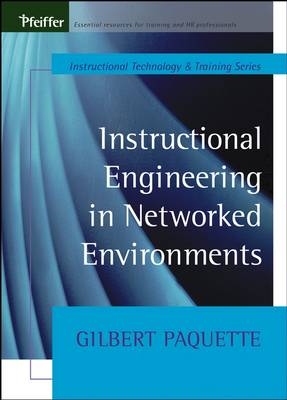
Instructional Engineering in Networked Environments
Pfeiffer (Verlag)
978-0-470-63139-3 (ISBN)
In this book, Gilbert Paquette?an internationally recognized expert in the field of technology-based training?offers IT professionals, trainers, and consultants a revolutionary method for going beyond simple information management. Instructional Engineering in Networked Environments introduces the instructional engineering method that elicits knowledge from subject matter experts to make information more widely available for training other people and transfering knowledge through formal and informal training using a variety of media and information sources. Throughout the book, Paquette shows that instructional engineering is based on the use of transferable graphic models that demonstrate how this engineering works in an environment with human networks and diversified information sources. This important book also includes illustrative examples of “artifacts” ? the actual jobs aids that hold an organization’s knowledge ? and provides numerous easily reproducible tools.
Gilbert Paquette is a professor at Tele-universite du Quebec, acting as director of the CIRTA Research Centre, an interuniversity research center hosted by the LICEF research center at Tele-universite. He is leading two important Canadian projects in the field of e-learning: eduSource and LORNET. Paquette has published three books and numerous articles and has supervised and participated in a dozen multimedia teletraining courses and many computer-based training environments.
List of Figures and Tables xv Foreword xix
M. David Merrill
Acknowledgments xxiii
Introduction xxv
Chapter 1: The E-Learning Challenge 1
The Knowledge Society 2
Knowledge Management 3
Pedagogy and Technology 5
Network-Based Learning Models 8
Processes and Development Tools 14
Platforms and Portals 19
Summary 22
Chapter 2: Virtual Learning Centers 25
The Concept of a Learning System 26
Actors' Roles and Resources 31
Explor@: A Web-Based Support System 40
Integrating a Learning Event into a Virtual Center 45
Versatile and Flexible Architecture 49
Summary 53
Chapter 3: Foundations of Instructional Engineering 55
Systemic Methods 56
Instructional Systems Design 60
Software Engineering 62
Knowledge Engineering 66
A Knowledge Representation System 69
Skills and Competencies 86
Summary 100
Chapter 4: MISA: An Instructional Engineering Method 103
Overview of the MISA Method 104
Conceptual Levels of a Learning System 109
Processes and Tasks 113
Operational Principles 115
Context and Frontier 119
Summary 121
Chapter 5: Instructional Engineering on the Web 125
General ADISA Features 126
Designing the Main Components of a Virtual Learning Center 132
Summary 141
Chapter 6: Reengineering a University Course for the Web 143
Definition of the Project 144
Preliminary Analysis 145
Architecture 149
Design of Learning Materials 156
Development and Validation 159
Delivery Planning 162
Discussion 163
Chapter 7: Engineering a Vocational E-Learning Environment 165
Definition of the Project 166
Preliminary Analysis 167
Architecture 171
Design of Learning Materials 175
Development and Validation 180
Delivery Planning 182
Discussion 183
Chapter 8: Engineering a Workplace E-Learning Environment 185
Definition of the Project 186
Preliminary Analysis 186
Architecture 191
Design of Learning Materials 192
Development and Validation 196
Delivery Planning 198
Discussion 199
Conclusion 201
Glossary 209
Notes 231
Bibliography 239
Index 249
About the Author 255
About the Series Editors 257
About the Advisory Board Members 261
| Erscheint lt. Verlag | 29.12.2009 |
|---|---|
| Sprache | englisch |
| Maße | 10 x 10 mm |
| Gewicht | 454 g |
| Themenwelt | Sozialwissenschaften ► Pädagogik ► Berufspädagogik |
| Wirtschaft ► Betriebswirtschaft / Management ► Personalwesen | |
| ISBN-10 | 0-470-63139-2 / 0470631392 |
| ISBN-13 | 978-0-470-63139-3 / 9780470631393 |
| Zustand | Neuware |
| Haben Sie eine Frage zum Produkt? |
aus dem Bereich


